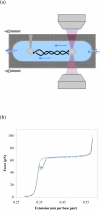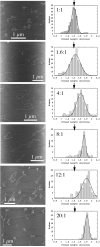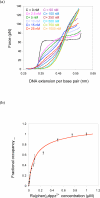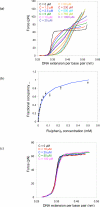Exploring the interaction of ruthenium(II) polypyridyl complexes with DNA using single-molecule techniques
- PMID: 16649785
- PMCID: PMC2519805
- DOI: 10.1021/la053242r
Exploring the interaction of ruthenium(II) polypyridyl complexes with DNA using single-molecule techniques
Abstract
Here we explore DNA binding by a family of ruthenium(II) polypyridyl complexes using an atomic force microscope (AFM) and optical tweezers. We demonstrate using AFM that Ru(bpy)2dppz2+ intercalates into DNA (K(b) = 1.5 x 10(5) M(-1)), as does its close relative Ru(bpy)2dppx2+ (K(b) = 1.5 x 10(5) M(-1)). However, intercalation by Ru(phen)3(2+) and other Ru(II) complexes with K(b) values lower than that of Ru(bpy)2dppz2+ is difficult to determine using AFM because of competing aggregation and surface-binding phenomena. At the high Ru(II) concentrations required to evaluate intercalation, most of the DNA strands acquire a twisted, curled conformation that is impossible to measure accurately. The condensation of DNA on mica in the presence of polycations is well known, but it clearly precludes the accurate assessment by AFM of DNA intercalation by most Ru(II) complexes, though not by ethidium bromide and other monovalent intercalators. When stretching individual DNA molecules using optical tweezers, the same limitation on high metal concentration does not exist. Using optical tweezers, we show that Ru(phen)2dppz2+ intercalates avidly (K(b) = 3.2 x 10(6) M(-1)) whereas Ru(bpy)3(2+) does not intercalate, even at micromolar ruthenium concentrations. Ru(phen)3(2+) is shown to intercalate weakly (i.e., at micromolar concentrations (K(b) = 8.8 x 10(3) M(-1))). The distinct differences in DNA stretching behavior between Ru(phen)3(2+) and Ru(bpy)3(2+) clearly illustrate that intercalation can be distinguished from groove binding by pulling the DNA with optical tweezers. Our results demonstrate both the benefits and challenges of two single-molecule methods of exploring DNA binding and help to elucidate the mode of binding of Ru(phen)3(2+).
Figures









Similar articles
-
Correlation Between Molecular Modelling and Spectroscopic Techniques in Investigation With DNA Binding Interaction of Ruthenium(II) Complexes.J Fluoresc. 2017 Mar;27(2):587-594. doi: 10.1007/s10895-016-1986-x. Epub 2016 Dec 6. J Fluoresc. 2017. PMID: 27924438 Review.
-
Photophysical properties of ruthenium(II) polypyridyl-gold(I) ethynyl dyads and triads containing mono- or diethynylphenanthroline incorporated into gold(I) triphenylphosphine organometallics.Inorg Chem. 2010 May 3;49(9):4186-93. doi: 10.1021/ic902417m. Inorg Chem. 2010. PMID: 20364844
-
Syntheses, characterization and DNA-binding study of chiral complexes DeltaDelta- and LambdaLambda-[Ru(bpy)2(bdptb)Ru(bpy)2]4+.J Inorg Biochem. 2004 Mar;98(3):497-501. doi: 10.1016/j.jinorgbio.2003.12.020. J Inorg Biochem. 2004. PMID: 14987851
-
Characterization of dipyridophenazine complexes of ruthenium(II): the light switch effect as a function of nucleic acid sequence and conformation.Biochemistry. 1992 Nov 10;31(44):10809-16. doi: 10.1021/bi00159a023. Biochemistry. 1992. PMID: 1420195
-
DNA binding, photocleavage, and topoisomerase inhibition of functionalized ruthenium(II)-polypyridine complexes.Chem Biodivers. 2008 Oct;5(10):1962-1979. doi: 10.1002/cbdv.200890181. Chem Biodivers. 2008. PMID: 18972534 Review.
Cited by
-
Torsional sensing of small-molecule binding using magnetic tweezers.Nucleic Acids Res. 2010 Nov;38(20):7122-32. doi: 10.1093/nar/gkq598. Epub 2010 Jul 12. Nucleic Acids Res. 2010. PMID: 20624816 Free PMC article.
-
Flexibility and thermal dynamic stability increase of dsDNA induced by Ru(bpy)2dppz2+ based on AFM and HRM technique.BMC Chem. 2019 May 17;13(1):68. doi: 10.1186/s13065-019-0584-9. eCollection 2019 Dec. BMC Chem. 2019. PMID: 31384815 Free PMC article.
-
Optical tweezers experiments resolve distinct modes of DNA-protein binding.Biopolymers. 2009 Apr;91(4):265-82. doi: 10.1002/bip.21123. Biopolymers. 2009. PMID: 19173290 Free PMC article. Review.
-
Mechanisms of small molecule-DNA interactions probed by single-molecule force spectroscopy.Nucleic Acids Res. 2016 May 19;44(9):3971-88. doi: 10.1093/nar/gkw237. Epub 2016 Apr 16. Nucleic Acids Res. 2016. PMID: 27085806 Free PMC article.
-
Left versus right: Exploring the effects of chiral threading intercalators using optical tweezers.Biophys J. 2022 Oct 4;121(19):3745-3752. doi: 10.1016/j.bpj.2022.04.025. Epub 2022 Apr 25. Biophys J. 2022. PMID: 35470110 Free PMC article.
References
-
- Kumar CV, Barton JK, Turro NJ. J. Am. Chem. Soc. 1985;107:5518–5523.
-
- Barton JK, Goldberg JM, Kumar CV, Turro NJ. J. Am. Chem. Soc. 1986;108:2081–2088.
-
- Pyle AM, Rehmann JP, Meshoyrer R, Kumar CV, Turro NJ, Barton JK. J. Am. Chem. Soc. 1989;111:3051–3058.
-
- Hiort C, Nordén B, Rodger A. J. Am. Chem. Soc. 1990;112:1971–1982.
-
- Lincoln P, Nordén B. J. Phys. Chem. B. 1998;102:9583–9594.
Publication types
MeSH terms
Substances
Grants and funding
LinkOut - more resources
Full Text Sources
Miscellaneous

